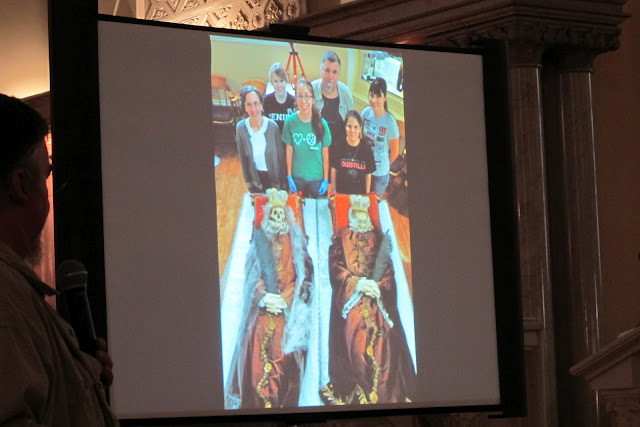"One of the major highlights of Fr. Zabler’s pastorate came on December 31, 1901, when St. Martin received possession of the relics of two martyrs, St. Magnus and St. Bonosa. During the early third century A.D., the emperor Diocletian vented his fury against Rome’s Christians. In an effort to purge these 'heretics,' he put to death more than 15,000 persons in a single month. Among those who died were Magnus, a Roman centurion who cast his lot with the Christians, and Bonosa, a Roman virgin.[1]"
This,
according to Church legend, is the account of SS. (saints) Magnus and Bonona,
whose remains have called St. Martin of Tours home since December 31, 1901.
Recently, with the permission of Joseph Kurtz, archbishop of Louisville,
Fr. Frederick Klotter allowed archaeologist Philip DiBlasi and four students
from the University of Louisville to examine the remains while the side altars, where the saints' bones rested, could be repaired.
After
Fr. Klotter spoke briefly on the legends behind the saints, Professor DiBlasi began to explain his team’s findings:
 |
| This ceramic container holds the blood of St. Magnus; these samples will be tested in the future. |
 |
| The remains of St. Bonosa are noticeably more complete; both were later confirmed to have their own bones (not mixed with other skeletons). |
Ultimately,
DiBlasi and his team were very pleased with their findings; it seems that these
skeletons of Magnus and Bonosa provide nothing to refute the legends that
accompany them. DiBlasi also noted how easily skeletons in Roman catacombs
(where they were originally placed after death) were mixed up, and bones
often filled in the gaps of other skeletons; this seems not to be the
case here.
Professor DiBlasi reveals the results of
his study.
In the case of SS. Magnus and Bonosa, and their skeletal remains, the future holds much promise. Testing will hopefully provide data from their blood, and computer reconstructions of their faces (at the very least, Bonosa, with her nearly complete skull) should finally reveal to us how the saints looked if we would have met them so many centuries ago or if, one day, we should encounter them in Heaven.
[1] Dr. Carl E. Kramer, PhD, “The Church of St. Martin
of Tours, A Brief History: 1853-1985.” In The Renaissance of The Church of
St. Martin of Tours by Deborah Yetter
(Shepherdsville, KY: Publishers Printing Company, 1992), 47.



No comments:
Post a Comment